 GREATEST PLAYERS OF ALL TIME (in order of position)
GREATEST PLAYERS OF ALL TIME (in order of position)CHAPTER 18
Our Game: Hockey Heroes
 GREATEST PLAYERS OF ALL TIME (in order of position)
GREATEST PLAYERS OF ALL TIME (in order of position)
Goalie:
1. Terry Sawchuk: Many consider him the greatest ever. His crouching style was innovative and helped him get his name on the Vezina Trophy four times. He recorded 103 shutouts during his 21-year career.
2. Jacques Plante: A creative and talented goalie who won seven Vezina trophies, six with the great Canadiens’ teams of the 1950s, and one jointly with Glenn Hall of the St. Louis Blues. He was at the top of his game in the 1950s and early 1960s, but was superb enough to later help less-talented teams such as the St. Louis Blues and the Toronto Maple Leafs.
3. Glenn Hall: He was called “Mr. Goalie” and his Calder Trophy, seven first-team all-star berths, 84 shutouts, and three Vezina trophies solidify him as one of the best.
4. Ken Dryden: A cool performer who played his best when the pressure was on, Dryden was a five-time first team all-star and winner of the Vezina Trophy five times in a relatively short, eight-year career.
5. Bill Durnan: Durnan was one of the best goalies in hockey’s “old days,” thanks to lightning-quick hands and the ability to stymie shooters by changing hands with his goal stick. He won six Vezina trophies and had six first-team all-star berths in just seven NHL seasons.
6. Patrick Roy: This Quebec native was one of the best in the league in the 1980s and 90s. He played in 11 all-star games and earned three Vezina Trophies over 19 NHL seasons. During the 2000–01 season he surpassed the legendary Terry Sawchuk for the most NHL career wins. His record of 551 victories between the pipes stood until March, 2009. He was also the first goalie to play in 1,000 career NHL games and had 12 30-win seasons. He retired in 2003.
7. Martin Brodeur: With his unique style, sharp reflexes, puck-handling abilities, and reliability, Brodeur well deserves to round out this list. He has been honoured with four Vezina Trophies and has 10 all-star game appearances. Still a key member of the New Jersey Devils at the time of printing, he is within reach of Sawchuk’s record for most career shutouts and has surpassed Patrick Roy’s record for career victories.
Defence:
1. Bobby Orr: Some consider him the perfect hockey player, and though he won the Norris Trophy as the best defenceman eight times, he also changed the game with his offensive skills. Bad knees kept him from having a longer and probably greater career.
2. Doug Harvey: A seven-time winner of the Norris Trophy, even though such an award didn’t exist for the first six years of his career. Many consider him the best defenceman ever.
3. Eddie Shore: A fearless and talented player with great skating skills that made him an offensive threat as well. And he did it long before Orr.
4. Denis Potvin: Some consider him the equal to Orr during the years they were in the league together. Potvin had similar offensive skills, but was a better bodychecker.
5. Ray Bourque: A superb all-round defenceman with five Norris Trophy wins. He has been favourably compared to Orr. He holds the current records for all-time points scored by a defenceman with 1,579, and for goals scored by a defenceman with 410. He also had an amazing 13 first-team all-star berths and a league-high number of consecutive appearances at all-star games with 19 (surpassing Wayne Gretzky’s previous record).
6. Larry Robinson: Creative with the puck, a decent goal scorer, and able to deliver devastating bodychecks, Robinson was a six-time all-star and double Norris Trophy winner. His 20-year career saw him win six Stanley Cups.
7. Red Kelly: Though he also excelled as a forward, he was a great defensive defenceman early in his career and played on many Stanley Cup-winning teams.
8. Paul Coffey: A great all-round defenceman who was a superb skater, playmaker, and goal-scorer. He has four Stanley Cup rings and has won the Norris Trophy three times.
9. Brad Park: Overshadowed during his career by Orr, Park was a five-time first-team all-star who had exceptional defensive skills.
10. Dit Clapper: The NHL’s first 20-year player, this six-time all-star made the smooth transition from right wing to defence 11 years into his career. Power, precision, and a knack for avoiding mistakes were Clapper’s hallmarks.
Centre:
1. Wayne Gretzky: He’s called “The Great One” for good reason. Gretzky hold so many records and has won so many awards it’s hard to keep track, and even in the twilight of his career he was still outshining most everyone in the game.
2. Mario Lemieux: The only player who has come close to matching Gretzky’s offensive skills, he was also a great playmaker, skater, and leader.
Hockey BITE!
Approximately 4.5 million Canadians are involved in hockey as coaches, players, officials, administrators, or direct volunteers. More than 540,000 players are registered with Hockey Canada, and between them they play more than 1.5 million games every season and take part in two million practices at Canada’s 3,500 arenas.
3. Jean Beliveau: A smooth and majestic player who was not only a perennial all-star, but a great leader who won 10 Stanley Cups during his career.
4. Howie Morenz: A speedy skater who had a flair for scoring dramatic goals. One of the best players in the first half of the 20th century.
5. Mark Messier: The man they called “Moose” is known as much for his leadership and dressing room presence as his ability to score big goals that turn around games. He is a six-time Stanley Cup winner and has five all-star selections and two Hart Trophies to his credit.
Left Wing:
1. Bobby Hull: “The Golden Jet” was the dominant player of his time, a great skater, legendary goal-scorer, and underrated checker and penalty killer.
2. Ted Lindsay: One of the toughest players in the game, a great goal-scorer, and first-team all-star eight times.
3. Frank Mahovlich: A gifted skater and stickhandler with a huge slapshot, “the Big M” could turn a team into a champion, as he did on several occasions. He won the Calder Trophy in his first season with the Toronto Maple Leafs and played on six Stanley Cup winners.
4. Dickie Moore: Although his career was plagued by injuries, Moore persevered to win two Art Ross Trophies, including in 1957–58 when he played with a broken wrist for the final three months of the season. Maurice Richard once called him the best left-winger he ever played with.
5. Johnny Bucyk: Often lost in the shadow of Bobby Orr and Phil Esposito, hard-hitting Bucyk was one of the league’s premier wingers but not until later in his career. After turning 32, he had seven 30-goal seasons, including his first 50-goal year. He won the Lady Byng Trophy twice and retired in 1978 as the fourth-leading NHL goal and point producer of all time.
Right Wing:
1. Gordie Howe: Until Gretzky came along, most considered him the greatest player ever. And with the kind of record he piled up over 34 incredible years he’s certainly the greatest right winger in the history of the game.
2. Maurice Richard: “The Rocket” was the dominating player of his day, an exciting and excellent goal-scorer who played with intensity and skill rarely matched.
3. Guy Lafleur: One of the dominant players of the 1970s, he was fast, scored a bucket of goals, and was a winner.
4. Mike Bossy: The New York Islander winger was one of the most prolific scorers in NHL history, notching 50 or more goals in nine consecutive seasons and helping his team to four consecutive Stanley Cups.
5. Charlie Conacher: Six feet one inches of determination and possessing the hardest shot in the league in the 1930s. Conacher was a hockey legend. He was a five-time all-star, won two Art Ross Trophies, scored more than 30 goals in four of his 12 seasons, and held or shared the league goal-scoring lead five times.
 WHERE ARE THEY NOW?
WHERE ARE THEY NOW?
 Dave Schultz
Dave Schultz
Vital Stats Dave Schultz was born on October 14, 1949, in Waldheim, Saskatchewan, and grew up in Rosetown, about an hour west of Saskatoon. For three years he played with the Swift Current Broncos, including during the team’s first year in the Western Hockey League. He finished his junior career with the Sorel Blackhawks of the Quebec Major Junior Hockey League and was selected by the Philadelphia Flyers in round five, number 52 overall, in the 1969 NHL Amateur Draft. He played for Roanoke and Richmond and the Quebec Aces of the American Hockey League before cracking the Flyers’ roster in 1972. He was a member of the Flyers for four seasons and also patrolled the wing with the Los Angeles Kings, Pittsburgh Penguins, and Buffalo Sabres. He retired in 1980 from Sabres affiliate, the Rochester Americans of the AHL.
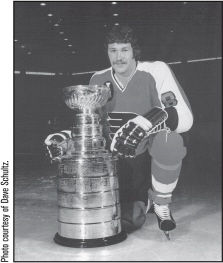
Schultz helped the Flyers win back-to-back cups in 1974 and 1975.
Claims to Fame
In 535 regular season NHL games, Schultz scored 79 goals and had 121 assists and added another 20 points in the playoffs. He helped the Flyers win Stanley Cups in 1974 and 1975 and make it to the finals in 1976. He’s best known, however, as an enforcer who racked up 2,294 regular season penalty minutes in the NHL and averaged 25 fights a season in his prime. He holds the NHL record for most penalty minutes in a season, 472 in 1974–75. Nicknamed “The Hammer,” he was part of the infamous Flyers’ teams known as the “Broad Street Bullies” whose rosters included tough guys Don “Big Bird” Saleski, Bob “Hound Dog” Kelly, and Andre “Moose” Dupont. Schultz and his tough-guy teammates deserve plenty of credit for turning a lacklustre early 1970s Flyers expansion team into a Cup winner. Schultz was more than an enforcer: he scored 20 goals for Philadelphia in 1973–74 and fired the series-clinching goal in overtime in the first round of the 1974 Stanley Cup playoffs against the Atlanta Flames.
Style
The six-foot, one-inch, 195-pound left-winger was known for his aggressive play and penchant for dropping his gloves to protect his teammates. Where is He Now? After retiring as a player, Schultz for three years coached teams in the United Hockey League and the East Coast Hockey League. He managed a hockey rink for 10 years and for 22 years has operated a limousine service in the Philadelphia area. He is a comedic and motivational speaker and in 2009 was running a website offering an online collection of vintage NHL hockey autographs and signed sports memorabilia; he was also working as a consultant to help companies streamline their operations. He lives in the Philadelphia area and has two sons, one of whom has written a movie script about the Hammer’s life in pro hockey.
Quotable Quote
“I hated fighting in junior … when a brawl started I would go to the bench and be glad to be there but that all changed. I got in a few fights in my first year out of junior … in the NHL tough guys were always needed and the fans certainly appreciated it when some guy was doing something to one of my teammates and I’d go and challenge them. It was the code — enforcers would do the policing ourselves.”
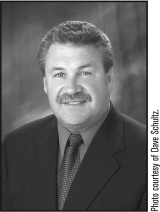
Dave Schultz is now a motivational speaker.
Fabulous Fact
Schultz was anything but a tough guy during his junior career, which saw him involved in just two fights. In his final year of junior, he scored 50 goals in 80 regular season and playoff games.
 Yvan Cournoyer
Yvan Cournoyer
Vital Stats
Yvan Cournoyer was born on November 22, 1943, in Drummondville, Quebec. He played minor hockey in his hometown before graduating to Junior B with the Lachine Maroons at age 13. Between 1961 and 1964, he played three seasons with the Montreal Junior Canadiens and first played with the Montreal Canadiens in the 1963–64 season when he was called up for five games.
Claims to Fame
During his junior career, Cournoyer racked up 115 goals and 91 assists in 121 regular season games. As a member of the Canadiens for 16 seasons, he scored 428 goals and 435 assists during the regular season and bagged another 64 goals and 63 assists in 147 playoff contests. In 11 seasons he scored 25 goals or more, with his most prolific season being 1968–69 when he recorded 87 points on 43 goals and 44 assists. He helped the Canadiens win 10 Stanley Cups, including 1972–73, when he was awarded the Conn Smythe Trophy as the most valuable player in the playoffs. He was captain of the Habs from 1975 to 1979. In 1972, Cournoyer scored three goals as a member of Team Canada during the Canada-Russia Summit Series, including the game winner in game two and the game-tying goal in game eight. In 1998, he was ranked number 98 on The Hockey News list of the 100 Greatest Hockey Players. The Canadiens retired uniform number 12 in honour of both Cournoyer and Dickie Moore in 2005.
Style
Dubbed “The Roadrunner” for his blazing speed and small stature (five-foot, eight inches, 179 pounds.), Cournoyer was an offensive-minded winger who used his speed to find openings and take passes that often turned into breakaways or odd-man rushes. Few players in NHL history have been as exciting to watch.
Where is He Now?
Cournoyer and his second wife live on a golf course in Blainville, Quebec, a Montreal suburb 25 minutes from the Bell Centre. The couple’s son was attending Georgian College in Barrie in 2008. Cournoyer also has three other children, two girls and a boy, from his first marriage. He coached the Montreal Roadrunners roller hockey team in 1994–95 and in 1996–97 was an assistant coach with the Canadiens. Along with former teammates Henri Richard, Jean Beliveau, Rejean Houle, and Guy Lafleur, he is an “ambassador” for the Canadiens, regularly attending banquets and golf tournaments and visiting hospitals on behalf of the team and through his Toronto agent is often booked to speak and sign autographs at corporate functions. He attends about half of the Canadiens’ games. In the summer he plays golf three times a week. In September 2008, he had an operation to repair a nerve problem in his back.
Cournoyer was one of seven legendary Canadiens alumni and team ambassadors introduced to the crowd during the NHL All-Star Game held in Montreal in January, 2009.
Quotable Quote
“We did it, we did it,” were Cournoyer’s jubilant words when he embraced Henderson after the latter scored the winning goal against Russia in the 1972 Summit Series.
Fabulous Facts
Cournoyer acquired his nickname from a Sports Illustrated writer after scoring two breakaway goals against the New York Rangers early in his career. He attributes his blistering shot to practising his shooting in summer in the family garage using heavier than normal pucks he made in his father’s machine shop. Cournoyer could shoot left and right, a talent that often dumfounded opposing goalies.
They Said it!
“Most young Canadians … are born with skates on their feet rather than with silver spoons in their mouths.”
— former prime minister Lester B. Pearson
 Danny Gare
Danny Gare
Vital Stats
Danny Gare was born in Nelson, British Columbia, on May 14, 1954. He played his minor hockey in the Nelson area before joining the Calgary Centennials of the Western Canada Hockey League in 1971 for three seasons. His Centennials’ teammates included future NHLers Bobby Nystrom, John Davidson, and Jimmy Watson. Gare was selected by the Buffalo Sabres in round two, 29th overall, in the 1974 NHL Amateur Draft and also by the Winnipeg Jets of the World Hockey Association in round three, 36th overall in the former league’s amateur draft. He chose Buffalo, where he played until the 1981–82 season when he joined the Detroit Red Wings for five seasons. A sore back convinced him to retire in 1987 after just 18 games with the Edmonton Oilers.
Claims to Fame
During 17 NHL seasons, Gare played in 827 regular season games, notching 354 goals and 331 assists. In 64 playoff games he added another 25 goals and 21 assists. He was never on a Stanley Cup-winning team but on two occasions with the Sabres he reached the 50-goal mark, notching 50 in 1975–76, while playing on a checking line with Don Luce and Craig Ramsay, and 56 in 1979–80. He scored the first goal of his career at the 18-second mark of the first period in a game against Boston. It was the second fastest goal ever scored by a rookie. In 1976, Gare helped Canada win the Canada Cup on a team stocked with superstars, including Bobby Hull, Darryl Sittler, Phil Esposito, and Bobby Orr.
Style
The five-foot, nine-inch, 175-pound forward was known for his quick wrist shot and status as a small, yet scrappy and fearless player.
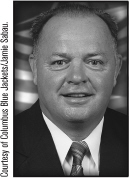
Danny Gare.
Where is He Now?
After retiring as a player, Gare dabbled in several careers including restaurant ownership and a computer company. He was involved in broadcasting and marketing in the initial years of the Tampa Bay Lightning franchise and for four years was the team’s assistant coach. He worked as a studio analyst and ice level reporter on Sabres broadcasts from 1987 to 1992 and 1995 to 2004; since 2006, he has been the colour commentator for the NHL’s Columbus Blue Jackets on Fox Sports Ohio, handling about 75 televised games a season. He spends summers in the Nelson area and regularly visits his two daughters and two grandchildren in Buffalo. He plays in the occasional Sabres Alumni hockey game. He lives in Columbus, Ohio, about 10 minutes from Nationwide Arena, home of the Blue Jackets.
Quotable Quote
“The key to a good colour commentator is being able to analyze the play and have stories to tell. I have many stories and I try to relate those to what comes up in the game.”
Fabulous Fact
Gare’s father, Ernie, was a solid senior hockey player who for 20 years was athletic director at Notre Dame University (now Selkirk College) in Nelson. The elder Gare started the first athletic scholarship program in Canada, and possibly North America. Ernie Gare also coached the university’s hockey team, which regularly defeated the team from the much larger University of British Columbia in Vancouver.
 Dickie Moore
Dickie Moore
Vital Stats
Dickie Moore was born in Montreal on January 6, 1931, and grew up in a family of nine boys and one girl. Despite a badly broken leg at the age of seven, he developed into a solid minor hockey player. In 1947–48 he played a partial season with the Montreal Junior Royals and a year later his offensive prowess helped the Royals become the first Memorial Cup champions from Quebec. He also starred with the Montreal Junior Canadiens and helped that team win a Memorial Cup. After becoming property of the Montreal Canadiens, he first skated with the Habs in 1951–52, registering a respectable 18 goals and 15 assists in 33 regular season games. After brief stints with the Royals and the AHL’s Buffalo Bisons, Moore graduated to the Canadiens for good in the 1954–55 season.
Claims to Fame
Moore played in the NHL until 1967–68, skating in 719 regular season games and notching 261 goals and 347 assists over 14 seasons, several of them on a line with Rocket Richard and his brother Henri. In 135 playoff games he scored another 110 points. He helped the Canadiens win six Stanley Cups, including five in a row with the great Canadiens teams of the late 1950s, and won the league scoring championship in both 1958 (84 points) and 1959 (96 points). He was inducted into the Hockey Hall of Fame in 1974. In 1998, he was ranked number 31 on The Hockey News’ list of the 100 Greatest Hockey Players.
Style
The five-foot-10-inch, 185-pound left-winger was known for his offensive prowess.
Where is He Now?
After brief stints with the Toronto Maple Leafs and St. Louis Blues, Moore retired in 1968 and has dedicated most of his energy to Dickie Moore Rentals, a Montreal-based company that he launched in 1961 while still playing hockey. The company rents construction equipment, storage containers, and office trailers and has branch offices in Toronto, Ottawa, and Longueil, Quebec. Moore lives in Montreal with his wife and regularly attends Canadiens’ games.
Quotable Quote
On former Canadiens coach Toe Blake: “When Toe became coach, I was elated. He kept me on the team. I was lucky to have a guy who believed in me. You’re only as good as how somebody can lift you up to the heights where he thinks you can play.”
Fabulous Fact
Although he grew up in Montreal, Moore did not cheer for the Canadiens at that time, ironic considering his later affiliation. He was a big fan of the Leafs and idolized Gordie Dril-lon, a productive winger who, like Moore, won two NHL scoring titles.
 LEGENDS OF THE GAME
LEGENDS OF THE GAME
 Ron Ellis: Mr. Dependable
Ron Ellis: Mr. Dependable
If there has ever been a winger who gave his all at both ends of the ice, while rarely being caught out of position, it’s Ron Ellis.
“Under coach Punch Imlach, it was not a good idea to wander off of your wing. If you did, you might be watching the rest of the game from the end of the bench,” says Ellis.
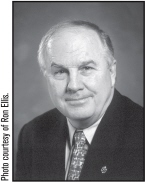
Ron Ellis is still involved in hockey with the Hockey Hall of Fame in Toronto.
Ellis was born on January 8, 1945, in Lindsay, Ontario, northeast of Toronto, and played his minor hockey mostly in Toronto and Ottawa. When he was 14 and attending high school in Ottawa, Toronto Maple Leafs coach Punch Imlach and general manager King Clancy visited his home and asked him to join the Toronto Marlboroughs junior hockey organization the following season.
He developed into a pro prospect and led the Marlies in goals during his Memorial Cup-winning year in 1963–64. He joined the Leafs in 1964, scoring 23 goals and narrowly losing the Calder Trophy for rookie of the year to Detroit netminder Roger Crozier. Ellis spent his entire career with the Leafs and retired in 1980 after playing in 1,034 games and notching 332 goals and 308 assists.
Sports BITE!
Prior to the 1968–69 season, former Maple Leafs great Irvine “Ace” Bailey insisted that Ellis wear his retired number 6 because he admired his high-calibre yet clean style of play. Ellis’s father, Randy, played with the Toronto Marlboroughs under Harold Ballard, coach of the team at the time and later owner of the Leafs.
In game six of the Stanley Cup finals in 1967, Ellis provided the crucial first goal to help the Leafs win the game 3–1 and take the Cup. In the 1972 Canada-Russia Summit Series, the five-foot-nine, 190-pounder was a member of the Team Canada squad that beat the Russians on Paul Henderson’s dramatic goal with only seconds remaining in the final game. He was on a line with Henderson and Bobby Clarke.
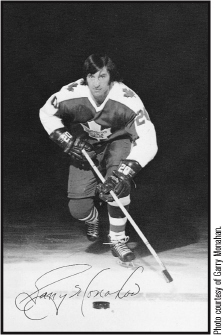
Garry Monahan wearing the blue and white.
After retiring from pro hockey, Ellis worked in the Toronto area as a teacher and in the insurance business and ran his own sporting goods store for six years. In 1993, he joined the Hockey Hall of Fame, where he is the director of public affairs and assistant to the president.
He supports the work of Christian Athletic Ministries and lives in Caledon East near Toronto with his wife, Jan.
 Garry Monahan: Drafted First
Garry Monahan: Drafted First
As professional hockey players go, Garry Monahan was never a household name. But when he was selected by the Montreal Canadiens in the National Hockey League entry draft in 1963, he became a part of hockey history.
Monahan, who was born October 20, 1946, was the first player picked in the first ever National Hockey League draft of amateur players 17 years of age and older.
The Barrie, Ontario, native, best known as a defensive forward in the NHL, played junior hockey with the St. Michael’s College organization, which has spawned many hockey greats, including Joe Primeau, Dave Keon, Red Kelly, Frank Mahovlich, and Eric Lindros.
He also skated for the Peterborough Petes and minor league teams in Houston and Cleveland before jumping to the NHL, where he played for the Canadiens, Detroit Red Wings, Los Angeles Kings, Vancouver Canucks, and Toronto Maple Leafs.
During his 12-year career, Monahan played in 748 regular season games and scored 116 goals and 169 assists. After retiring from the NHL in 1979, he played amateur hockey in Japan for three years with the Seibu Bears. While in Japan he earned his teaching degree. When he returned to Vancouver he earned his stock broker’s licence and worked within that field for five years before getting his real estate licence; Monahan became a real estate agent in 1990. He lives in West Vancouver, where he is an agent with Royal LePage Garry Monahan Realty Ltd.
After staying off skates for 20 years, he tied up the blades in 2003 as a member of the Canucks alumni. He also plays golf and tennis and spends many winter weekends skiing at Whistler.
Sports BITE!
The second player taken in the 1963 draft was Peter Mahovlich, who later joined the Detroit Red Wings. Coincidentally, about three years into their careers, the two swapped teams, with Monahan going to Detroit and Mahovlich to Montreal.
 Willie O’Ree: Cracking the Colour Barrier
Willie O’Ree: Cracking the Colour Barrier
Willie O’Ree became the first black athlete to play in the National Hockey League when he debuted with the Boston Bruins in 1958.
But breaking down the colour barrier in hockey, an accomplishment that often saw him referred to as “the Jackie Robinson of Hockey,” was not the New Brunswick native’s only claim to fame.
Unknown to many, O’Ree played pro hockey for more than two decades without any vision in his right eye. Despite his disability, he was usually among the top scorers in the leagues he played in.
O’Ree was born in Fredericton on October 15, 1935, the youngest of 13 children, and like many Canadians, he learned to play hockey on a backyard rink made with a garden hose by his father. He skated with the Fredericton Capitals Senior A team before playing junior hockey with the Quebec Frontenacs and Kitchener-Waterloo Canucks in the mid-1950s.
Sports BITE!
Following his eye injury, doctors told O’Ree his career was finished. But he continued to play, and the only people who knew about his disability were his younger sister, Betty, of Montreal, and a close friend, Stan Maxwell, of Truro, Nova Scotia. His bad eye was replaced with a prosthesis in the early 1980s.
In 1956, after being scouted by Punch Imlach (later coach and general manager of the Toronto Maple Leafs), he turned professional with the Quebec Aces of the Quebec Hockey League and went on to a 21-year pro career, which included parts of two seasons as a winger with the Boston Bruins.
When he played for the Bruins on January 18, 1958, wearing sweater number 22, he became the first black man to play in the NHL before being shipped back to the Aces. He played in two games with the Bruins that season. In 1956–57 he helped the Quebec Aces win the Duke of Edinburgh Trophy as QHL champs. In 1960–61, he was called up to the Bruins again, this time skating in 43 games. In 45 games with Boston he notched four goals and 10 assists.
Much of his career was spent in the Western Hockey League, where he topped the 30-goal mark four times.
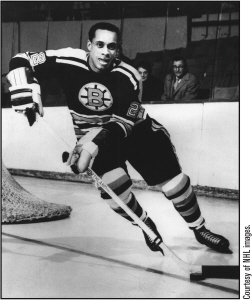
Willie O’Ree made history when he donned the Bruins uniform in 1958.
Despite losing 97 percent of the sight in his eye after being hit by a puck while playing with the Kitchener-Waterloo Canucks, he won two WHL scoring titles — in 1964–65 when he notched 38 goals and 21 assists for the Los Angeles Blades and in 1968–69 when he scored 38 goals and 41 assists for the San Diego Gulls. He was named to the WHL all-star team three times.
Remembering his days playing hockey in all-white leagues, O’Ree says, “I heard the racial remarks from players and fans … I wanted to concentrate on hockey and I soon found that the names never hurt unless you let them. I told myself ‘I am proud of who I am and I can’t change the colour of my skin.’”
O’Ree retired following the 1978–79 season, in which he played in 53 games with the San Diego Gulls of the Pacific Hockey League. Since then he has lived in the San Diego area, where he has dabbled in a handful of careers, including construction, athletic equipment sales, fast food outlet management, automobile sales, and security. A new career dawned in 1995, when he was hired as an ambassador for the NHL’s diversity program.
O’Ree is director of Youth Development for NHL Diversity, a job that involves on- and office clinics, speaking engagements, and personal appearances to introduce children with diverse ethnic backgrounds to hockey and help them pay for hockey equipment.
Since 1995, the program has involved more than 40,000 children in the United States and Canada, including goalie Gerald Coleman of Illinois, who played for the London Knights of the OHL and was drafted by the NHL’s Tampa Bay Lightning in 2003.
O’Ree lives in La Mesa, California, a suburb of San Diego, with his wife, Deljeet, and daughter, Chandra. In 1999 he published a children’s book The Autobiography of Willie O’Ree: Hockey’s Black Pioneer. A documentary, Echoes in the Rink: The Willie O’Ree Story, recounts his life.
In October 2005, he was among 10 people named to the Order of New Brunswick and in December of 2008, he received the Order of Canada.
 Denis Potvin: Stellar NHL Blueliner
Denis Potvin: Stellar NHL Blueliner
When the New York Islanders drafted Denis Potvin first overall in 1973, it was hoped the young defenceman from Ottawa would be a good foundation to improve the lowly expansion team that finished in last place in its first two years of play.
Potvin surpassed these expectations: during a 15-year career played entirely with the Islanders, he was one of the cornerstones that held the franchise together and eventually turned the team into a dynasty.
The former star of the Ottawa 67’s of the Ontario Hockey Association (now the Ontario Hockey League) quickly became one of the most complete defenders to step onto the ice, helping the Islanders win four straight Stanley Cups from 1980 to 1983, along the way becoming the first NHL defenceman to score 1,000 career points.
Potvin’s wealth of natural talent allowed him to jump into the offensive rush while serving as a tough physical presence in his own end of the rink. His mean streak caused many an opposing forward to stay off his side of the ice.
At age 14, Potvin broke into the OHA with the 67’s and played five seasons, beginning with the 1968–69 campaign. In his last season with Ottawa, he broke the scoring record for OHA defenceman with 123 points. He won two consecutive Kaminsky Awards as the league’s premier rearguard.
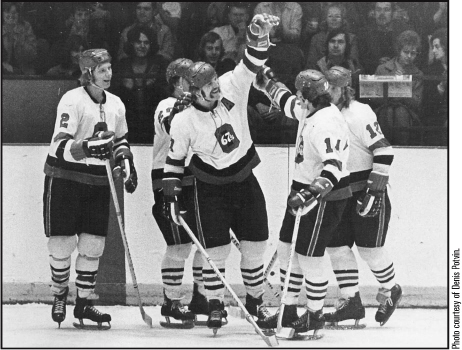
Denis Potvin started his career with the Ottawa 67’s.
As an NHLer, he played in 1,060 regular season games, notching 310 goals and 742 assists, plus another 56 goals and 108 assists in the playoffs. In addition to four Stanley Cups, he won three Norris Trophies as the league’s best defenceman, plus the Calder Trophy in 1974 as the league’s best rookie.
In 1991 he was inducted into the Hockey Hall of Fame and Canada’s Sports Hall of Fame. On March 31, 1988, a cheering crowd at the Nassau Coliseum on Long Island paid homage to his stellar career when his number 5 sweater was hung from the rafters.
After retiring from the Islanders in 1988, he worked in New York City as a commercial real estate agent and stockbroker. He also worked part-time as an in-studio hockey analyst with the Sports Channel New York. In 1993, he became a colour analyst for the NHL’s Florida Panthers and now works with the Fox Sports Network.
Potvin was living in the Fort Lauderdale, Florida, area with his wife, Valerie, daughters Madeleine and Annabelle, and son Christian. The family vacations from June to September at their summer home in Mont Tremblant, Quebec.
 Manon Rheaume: Breaking the Ice
Manon Rheaume: Breaking the Ice
Manon Rheaume hasn’t faced a blistering slapshot since 2000, but the woman who broke ground in North American sport by becoming the first female to play in a National Hockey League game is still close to the game she loves.
When the native of the Quebec City suburb of Lac Beauport inked a deal to play goal with the Tampa Bay Lightning in 1992, she became the first woman to sign a professional contract, the first to try out for an NHL team, and the first to play on a major men’s professional team.
Rheaume, who was born on February 24, 1972, played in parts of two exhibition games with the Lightning — one period against the St. Louis Blues in 1992 and one period in 1993 against the Boston Bruins. In both games she allowed two goals.
She also helped backstop the Team Canada women’s team to a silver medal at the 1998 Winter Olympics in Nagano, Japan, allowing four goals on 54 shots, and won gold medals at the World Championships in 1992 (1.72 goals-against average in four games) and 1994 (0.67 goals-against average in five games). She was named to the all-star team both years.
Rheaume began skating on her family’s backyard rink at the age of four, and by five was dressed up as a goaltender (snow pants, goalie gloves, and sometimes a helmet) so her two brothers could practise their slap shots. Her first stint as a goalie in organized hockey was in 1978 when she tended the nets for her brothers’ team, coached by her father, Pierre.
She played with various boys’ teams in the Quebec City area, and in 1984, at age 10, practised with the Quebec Nordiques of the NHL and became the first girl to play in the Quebec International Pee Wee Hockey Tournament. She was regularly cut from top-level AA teams in favour of less talented male goalies.
At 19, she became the first woman to play in a Junior A men’s hockey game when she tended goal for the Trois-Rivières Draveurs of the Quebec Major Junior Hockey League, allowing three goals in the 17 minutes she was between the pipes.
When she appeared in the Atlanta Knights’ 4–1 loss to Salt Lake City in the International Hockey League on December 13, 1992, Rheaume became the first woman to play in a regular-season professional game.
Her pro career spanned 1992 to 1997 and saw her play 24 games for seven pro teams, the Atlanta Knights, Knoxville Cherokees, Nashville Knights, Las Vegas Aces, Tallahassee Tiger Sharks, Las Vegas Thunder, and Reno Renegades.
At five feet seven inches tall and 130 pounds — compared to male goalies who are often six feet tall and 200 pounds — Rheaume used quickness and a butterfly style to compensate for her smaller size.
Her pioneering efforts and good looks attracted worldwide attention. At one point she turned down an offer to pose for Playboy magazine.
After leaving hockey in 2000, Rheaume worked as director of marketing for Mission Hockey in Irving, California, for three years, where she helped market and develop hockey equipment for girls. She then worked for two years in Milwaukee as director of girls’ hockey/ marketing for POWERade Iceport, a sports complex that included rinks for hockey, figure skating, and roller hockey.
When the POWERade project stalled she looked for a new challenge and was hired in August 2005 as director of sales and marketing for the Central Collegiate Hockey Association in Farmington Hills, Michigan. Her job involves attracting corporate partners and demonstrating the potential of marketing their products and services in conjunction with the 12-team college hockey association.
She knows she has helped the cause of women in the male-dominated world of sport but insists she is one of many females who have done their part, including golfers Annika Sorenstam and Michelle Wie and racing car driver Danica Patrick.
“I am one of a lot of women including the entire Canadian women’s national [hockey] team who has helped the cause of women in professional sports … but when I hear about young girls who say they have a poster of me in their bedroom and they want to be like me, it is most satisfying to think that I may make a difference in a girl’s life.”
She formed the Manon Rheaume Foundation in 2008, which “provides scholarships for young women to assist them as they seek to fulfill their aspirations.”
She currently resides with her family in Northville, Michigan, about 50 kilometres from Detroit.
Hockey BITE!
In 2004, Rheaume coached a girls’ all-star team that competed with boys’ teams in an international Pee Wee tournament in Quebec. Her team reached the semifinals but was not invited back the following year.
 STANLEY CUP QUIZ
STANLEY CUP QUIZ
The Stanley Cup, the supreme trophy in all of hockey, has been hoisted by some of the most famous names in the history of the game.
Let’s see how much you know about hockey’s most elusive prize.
1. What was original name of the Stanley Cup?
a) The Upper Canada Cup
b) The Dominion Hockey Challenge Cup
c) The Macdonald Trophy
2. Approximately how much did it cost to make the first Stanley Cup?
a) $100
b) $50
c) $1,050
3. Which Canadian team last won the Stanley Cup? (as of May, 2009) 4. True or false? The Stanley Cup has been to the White House.
5. What was the Montreal Victo-rias claim to fame in Stanley Cup history?
a) They won the cup with a team consisting of only seven players.
b) They won the cup in 1899 but refused to accept it.
c) They were the first team to accomplish a “hat trick”
by winning the cup three years in a row.
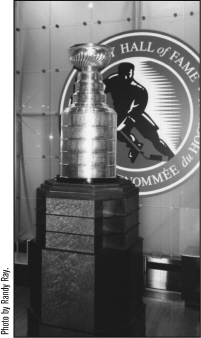
Lord Stanley’s Cup.
6. What do Brendan Shanahan, Brett Hull, and Howie Morenz have in common?
a) All have scored Stanley Cup-winning goals.
b) All were captains when their teams won the cup.
c) None have ever played on Stanley Cup-winning teams.
7. Where was the first Stanley Cup made?
a) Toronto
b) Halifax
c) Sheffield, England
d) Boston, Massachusetts
8. Which team was the first winner of the Stanley Cup?
a) Toronto Arenas
b) Montreal Amateur Athletic Association
c) Ottawa Senators